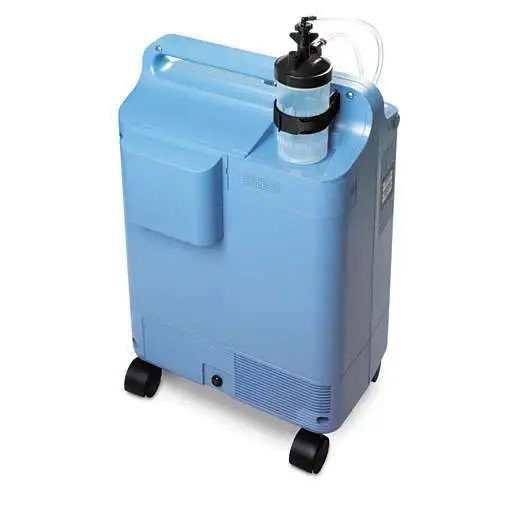Regular maintenance of oxygen concentrators is important to ensure their optimal performance. So, how do you maintain your machine’s efficacy and lengthen its lifespan?
Well, we’re here to help! This article provides helpful maintenance tips and troubleshooting hacks to keep your equipment in top condition.
An important note to keep is mind is that regular maintenance extends beyond simply wiping the exterior. Oxygen concentrator filter cleaning, humidifier maintenance, and connector upkeep are equally important aspects of comprehensive oxygen concentrator care.
Understanding Your Oxygen Concentrator
Oxygen concentrators work by absorbing air and filtering away nitrogen, leaving a more concentrated 95% oxygen. Then, the patient receives oxygen through a nasal cannula or face mask.
There are two kinds of oxygen concentrators on the market: stationary and portable. If you’re always on the go, having a portable oxygen concentrator, like the Philips SimplyGo, is more convenient. However, portable oxygen concentrators provide less oxygen compared to stationary ones because most of them deliver on-demand oxygen. They provide a pulse of oxygen only when the user inhales and “triggers” the machine.

If you need a steady supply of homecare oxygen, a stationary concentrator is your best choice. Unlike portable oxygen concentrators, stationary O2 machines provide more flow per minute. The Philips EverFlo Oxygen Concentrator is a perfect example, providing a maximum oxygen flow of 5 LPM.
Sometimes breathing in medical oxygen can lead to some uncomfortable side effects such as dry nose. If that’s the case, you can use a bottle humidifier to add some moisture to the dry oxygen from your machine. You can also soothe your nose with a water-based moisturizer.
If you have the following medical conditions, your doctor may require you to use an oxygen concentrator:
- Lung diseases such as asthma, pneumonia, bronchitis, and emphysema
- Chronic Obstructive Pulmonary Disease (COPD).
- Lung cancer or heart failure
Routine Maintenance Steps
By following the oxygen concentrator maintenance checklist below, you can safeguard the longevity of your device and enjoy a reliable source of life-sustaining oxygen straight to your lungs.
Cleaning and Replacing Filters
Oxygen concentrators have two types of filters: internal and external. Internal filters have a lifespan of 2 years. It’s important to note that these items cannot be washed and must be replaced if they become damaged or are used by different patients.
Meanwhile, external filters (HEPA or air intake filters) need washing every week or whenever necessary to keep them clean.
Oxygen concentrator filter cleaning only requires three simple steps:
- Remove the filter.
- Wash with mild soap and water.
- Wipe it clean and let it air dry.
Cleaning the Exterior
Dirt and debris can accumulate on the exterior of your oxygen machine over time, so an important part of the maintenance of oxygen concentrator is cleaning the outside. Once a week, make sure to:
- Turn off and unplug the oxygen machine.
- Use a clean, wet cloth to wipe its surface.
- Don’t wipe the air vents, instead, use cotton swabs to remove dust and other debris from the vents.
Checking Power Cords and Oxygen Equipment
Inspecting your oxygen concentrator’s power cord and connectors, including masks, cannulas, and humidifiers is essential to prevent environmental and health hazards.
Make sure you regularly:
- Check for damages like cracks or discoloration in the power cord and replace as needed.
- Clean your nasal cannula or oxygen mask once a week with mild soap and water. Make sure to disinfect using a 1:10 vinegar-water solution afterwards.
- Avoid overusing your nasal cannula or oxygen mask. Replace every 2-3 months.
- Wipe the cannula’s tubing connector daily with alcohol.
- Clean your bottle humidifier every three days using mild soap and hot water. Rinse well and dry with a clean cloth, making sure to avoid touching the inside.
Maintaining Proper Airflow
Without adequate airflow, the oxygen machine will not be able to produce the concentrated oxygen you need. Also, it may overheat and malfunction.
There are two simple things you can do to maintain proper airflow for your portable or home care oxygen concentrator:
- Clean the air intake filter and exhaust vent.
- Place the concentrator in a well-ventilated area.
Monitoring Oxygen Purity
Oxygen concentrators yield up to 95% oxygen, surpassing the 21% in room air that we breathe. Incorrect usage of these devices can contaminate the oxygen supply, significantly affecting its purity.
You can measure your oxygen concentration levels using an oxygen purity meter, with a standard concentration between 85% and 99%. However, medical-grade oxygen should range from 90 to 96%.
Troubleshooting Common Issues
Like any machine, oxygen concentrators experience problems from time to time. By understanding the most common issues and learning to troubleshoot them, you save money on repairs.
- Alarm beeping: Reset the oxygen concentrator. Turn off the device and unplug it. Wait a few minutes and plug it back on.
- No Breath Error: Check the correct positioning of the nasal cannula.
- Oxygen Processing Issue: Reboot the system.
- Charging Trouble: Examine the charging cable and battery.
- Air Purity Error: Contact your oxygen supplier for assistance. The oxygen sieve beds may need replacing.
- Overheating: Avoid direct sunlight, clear any vent blockages, or place it in a well-ventilated area.
Special Care Instructions
In addition to the above recommendations, here are some particular home and portable oxygen concentrator maintenance instructions:
- Avoid using harsh chemicals when cleaning the machine’s exterior or filters.
- Do not disassemble the oxygen concentrator.
- Be careful not to drop or mishandle the oxygen concentrator.
- Store the oxygen concentrator in a cool, dry place when it is not in use.
Safety Considerations
The care of oxygen equipment extends beyond its routine maintenance. Users should also take safety precautions to prevent accidents as oxygen can be dangerous if not used properly.
Although oxygen is not flammable, it’s a powerful oxidizing agent that supports combustion during fire accidents.
All the more reason why we need to take proper care of our oxygen equipment. Here are some important home oxygen safety considerations to keep in mind:
- Unplug the oxygen concentrator power cord when not in use.
- Keep the concentrator away from flammable materials.
- Do not put water near the machine.
- Do not plug the oxygen device into an outlet shared by other appliances.
- Avoid exposing batteries to extreme temperatures.
Long-Term Maintenance
Home and portable oxygen concentrator maintenance is crucial for smooth machine operation in the long run. Each unit comes with a detailed user manual that guides you through proper machine care and usage. In addition to following the cleaning steps outlined in the oxygen concentrator maintenance checklist above, it’s also important to familiarize yourself with your machine’s manual.
Your user manual covers in-depth troubleshooting steps that can help you fix complicated and machine-specific problems. It also contain information about the manufacturer’s warranty so you’ll want to make sure you give it a thorough read.
Summary
Regular maintenance of oxygen concentrators is vital to ensure the longevity of your device.
You can monitor your oxygen concentrator and its components by taking note of the following:
- Clean the machine’s surface, external filters, oxygen mask, and nasal cannula weekly.
- Clean the humidifier every three days and the cannula tubing connector daily.
Additionally, understanding the differences between home and portable oxygen concentrators is also vital. With so many brands of oxygen concentrators on the market, it can be overwhelming to try to figure out which oxygen machine you need. That’s where RespShop comes in.
We have an experienced team of medical staff who can help you figure out which oxygen concentrator is the best fit for your prescription and lifestyle. Use one of the methods below to get in touch with us for expert advice and care!






